132 books about Patients and 6
start with H
132 books about Patients and 6
132 books about Patients
6 start with H start with H
6 start with H start with H
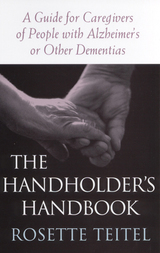
The Handholder's Handbook
A Guide for Caregivers of People with Alzheimer's or Other Dementias
Teitel, Rosette
Rutgers University Press, 2001
In a national survey, 19 million Americans said they have a family member with Alzheimer's, and 37 million said they knew someone who had it. But when Rosette Teitel found herself in the role of caregiver to her ailing husband, she could find no books that answered her practical needs: How do you give a 170-pound man a shower? How do you pick him up when he falls? What support networks are available? When is it time to consider a nursing home and how do you find one?
While many books about Alzheimer's disease focus on the illness and the patient, Teitel draws on her own experience to tackle subjects rarely dealt with in other self-help books. She covers topics such as managing the expenses of long-term care through Medicaid, estate planning, and preparing for the patient's death and the loss of someone whose daily survival has been at the center of one's existence. The chapters contain information on diagnosis, treatment, and the progression of the disease; the physical and emotional changes involved with the day-to-day caregiving; support networks; nursing homes; finances; death of the patient; mourning, and life after the patient's death; and interviews with caring children of parents with Alzheimer's disease. In addition, Teitel provides a helpful list of frequently asked questions, scheduling and memory aids, and websites where readers can find resources.
[more]

Heart 2 Heart
Stories from Patients with Left Ventricular Assist Devices
Edited by Ruth Halben, M.S.W.
Michigan Publishing Services, 2016
Heart 2 Heart brings together stories of patients who suffered from a serious heart condition and therefore received an LVAD (Left Ventricular Assist Device). The patients describe the various
hardships they and their families endured as well as how many found hope after receiving an LVAD.
Each chapter is written by a different patient or a patient’s family member, creating a unique
collection of stories that reveals the realities of living life with an implanted heart pump. Heart 2 Heart is composed of seventeen patient voices, where fourteen males and three females of different ethnicities and ages share with the reader their tale--from their initial diagnosis, to their eventual LVAD procedure performed at the University of Michigan Hospital.
The editor, Ruth Halben, M.S.W., is a clinical social worker in the University of Michigan Health System who works with LVAD patients and their families. Ruth is one of the first LVAD social workers in the nation, and she draws both from her expertise and her heartfelt relationships with her patients to bring together this wonderful resource for current and future LVAD patients.
hardships they and their families endured as well as how many found hope after receiving an LVAD.
Each chapter is written by a different patient or a patient’s family member, creating a unique
collection of stories that reveals the realities of living life with an implanted heart pump. Heart 2 Heart is composed of seventeen patient voices, where fourteen males and three females of different ethnicities and ages share with the reader their tale--from their initial diagnosis, to their eventual LVAD procedure performed at the University of Michigan Hospital.
The editor, Ruth Halben, M.S.W., is a clinical social worker in the University of Michigan Health System who works with LVAD patients and their families. Ruth is one of the first LVAD social workers in the nation, and she draws both from her expertise and her heartfelt relationships with her patients to bring together this wonderful resource for current and future LVAD patients.
[more]
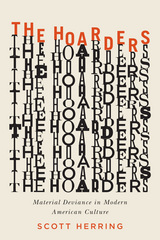
The Hoarders
Material Deviance in Modern American Culture
Scott Herring
University of Chicago Press, 2014
The verb “declutter” has not yet made it into the Oxford English Dictionary, but its ever-increasing usage suggests that it’s only a matter of time. Articles containing tips and tricks on how to get organized cover magazine pages and pop up in TV programs and commercials, while clutter professionals and specialists referred to as “clutterologists” are just a phone call away. Everywhere the sentiment is the same: clutter is bad.
In The Hoarders, Scott Herring provides an in-depth examination of how modern hoarders came into being, from their onset in the late 1930s to the present day. He finds that both the idea of organization and the role of the clutterologist are deeply ingrained in our culture, and that there is a fine line between clutter and deviance in America. Herring introduces us to Jill, whose countertops are piled high with decaying food and whose cabinets are overrun with purchases, while the fly strips hanging from her ceiling are arguably more fly than strip. When Jill spots a decomposing pumpkin about to be jettisoned, she stops, seeing in the rotting, squalid vegetable a special treasure. “I’ve never seen one quite like this before,” she says, and looks to see if any seeds remain. It is from moments like these that Herring builds his questions: What counts as an acceptable material life—and who decides? Is hoarding some sort of inherent deviation of the mind, or a recent historical phenomenon grounded in changing material cultures? Herring opts for the latter, explaining that hoarders attract attention not because they are mentally ill but because they challenge normal modes of material relations. Piled high with detailed and, at times, disturbing descriptions of uncleanliness, The Hoarders delivers a sweeping and fascinating history of hoarding that will cause us all to reconsider how we view these accumulators of clutter.
In The Hoarders, Scott Herring provides an in-depth examination of how modern hoarders came into being, from their onset in the late 1930s to the present day. He finds that both the idea of organization and the role of the clutterologist are deeply ingrained in our culture, and that there is a fine line between clutter and deviance in America. Herring introduces us to Jill, whose countertops are piled high with decaying food and whose cabinets are overrun with purchases, while the fly strips hanging from her ceiling are arguably more fly than strip. When Jill spots a decomposing pumpkin about to be jettisoned, she stops, seeing in the rotting, squalid vegetable a special treasure. “I’ve never seen one quite like this before,” she says, and looks to see if any seeds remain. It is from moments like these that Herring builds his questions: What counts as an acceptable material life—and who decides? Is hoarding some sort of inherent deviation of the mind, or a recent historical phenomenon grounded in changing material cultures? Herring opts for the latter, explaining that hoarders attract attention not because they are mentally ill but because they challenge normal modes of material relations. Piled high with detailed and, at times, disturbing descriptions of uncleanliness, The Hoarders delivers a sweeping and fascinating history of hoarding that will cause us all to reconsider how we view these accumulators of clutter.
[more]
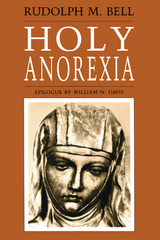
Holy Anorexia
Rudolph M. Bell
University of Chicago Press, 1985
Is there a resemblance between the contemporary anorexic teenager counting every calorie in her single-minded pursuit of thinness, and an ascetic medieval saint examining her every desire? Rudolph M. Bell suggests that the answer is yes.
"Everyone interested in anorexia nervosa . . . should skim this book or study it. It will make you realize how dependent upon culture the definition of disease is. I will never look at an anorexic patient in the same way again."—Howard Spiro, M.D., Gastroenterology
"[This] book is a first-class social history and is well-documented both in its historical and scientific portions."—Vern L. Bullough, American Historical Review
"A significant contribution to revisionist history, which re-examines events in light of feminist thought. . . . Bell is particularly skillful in describing behavior within its time and culture, which would be bizarre by today's norms, without reducing it to the pathological."—Mary Lassance Parthun, Toronto Globe and Mail
"Bell is both enlightened and convincing. His book is impressively researched, easy to read, and utterly fascinating."—Sheila MacLeod, New Statesman
"Everyone interested in anorexia nervosa . . . should skim this book or study it. It will make you realize how dependent upon culture the definition of disease is. I will never look at an anorexic patient in the same way again."—Howard Spiro, M.D., Gastroenterology
"[This] book is a first-class social history and is well-documented both in its historical and scientific portions."—Vern L. Bullough, American Historical Review
"A significant contribution to revisionist history, which re-examines events in light of feminist thought. . . . Bell is particularly skillful in describing behavior within its time and culture, which would be bizarre by today's norms, without reducing it to the pathological."—Mary Lassance Parthun, Toronto Globe and Mail
"Bell is both enlightened and convincing. His book is impressively researched, easy to read, and utterly fascinating."—Sheila MacLeod, New Statesman
[more]
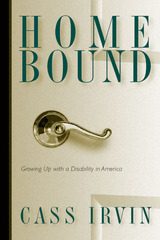
Home Bound
Growing Up With A Disability
Cass Irvin
Temple University Press, 2003
"When I was growing up, I learned that if you were a girl you went to school and college, then you married, became a wife and had a family. . . . When I became disabled, my journey, I was pretty sure, was not going to take me in those directions. What was I supposed to be? What kind of life was I supposed to have?"Once polio had made her a quadriplegic, Cass Irvin didn't know where she fit in or what would become of her. Neither did her parents, teachers, counselors, or rehabilitation therapists. And so began her search for a place to call home.In this memoir, Cass Irvin tells of the remarkable journey that transformed her from a young girl too timid to ask for help to a community activist and writer who speaks forcefully about the needs of people with disabilities. As a young girl she was taken to Warm Springs, Georgia, where she learned about living as a disabled person and found a hero in Franklin Delano Roosevelt, the famously if silently disabled president. Bright and inquisitive, Cass soon began to question the prevailing assumptions of a society that had no place for her and to question her own meekness.In time, her keen sense of injustice gave her the courage to fight for a college education. That personal victory emboldened her to find the means to live independently, but it also persuaded her that political work is the key to enabling all people with disabilities to live fulfilling lives. This book, then, is testimony to the importance of community building and organizing as well as the story of one woman's struggle for independence.
[more]
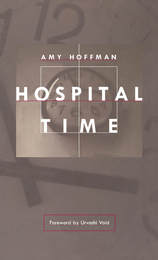
Hospital Time
Amy Hoffman
Duke University Press, 1997
Hospital Time is a memoir about friendship, family, and caregiving in the age of AIDS. Amy Hoffman, a writer, lesbian activist, and former editor of Gay Community News, chronicles with fury and unflinching honesty her experience serving as primary caretaker for her friend and colleague, Mike Riegle, who died from AIDS-related complications in 1992. Hoffman neither idealizes nor deifies Riegle, whom she portrays as a brilliant man, devoted prison rights activist, and very difficult friend.
Hoffman became central to Riegle’s caregiving when he asked her to be his health-care proxy, and although she willingly chose to do this, she explores her conflicting feelings about herself in this role and about her involvement with Riegle and his grueling struggle with hospitalization, illness, and, finally, death. She tells of the waves of grief that echoed throughout her life, awakening memories of other losses, entering her dreams and fantasies, and altering her relationships with friends, family, and even total strangers.
Hoffman’s memoir gives voice to the psychological and emotional havoc AIDS creates for those in the difficult role of caring for the terminally ill and it gives recognition to the role that lesbians continue to play in the AIDS emergency. A foreword by Urvashi Vaid, former executive director of the National Gay and Lesbian Task Force, offers a meditation on the politics of AIDS and the role of family in the lives of lesbians and gay men.
Hoffman became central to Riegle’s caregiving when he asked her to be his health-care proxy, and although she willingly chose to do this, she explores her conflicting feelings about herself in this role and about her involvement with Riegle and his grueling struggle with hospitalization, illness, and, finally, death. She tells of the waves of grief that echoed throughout her life, awakening memories of other losses, entering her dreams and fantasies, and altering her relationships with friends, family, and even total strangers.
Hoffman’s memoir gives voice to the psychological and emotional havoc AIDS creates for those in the difficult role of caring for the terminally ill and it gives recognition to the role that lesbians continue to play in the AIDS emergency. A foreword by Urvashi Vaid, former executive director of the National Gay and Lesbian Task Force, offers a meditation on the politics of AIDS and the role of family in the lives of lesbians and gay men.
[more]
READERS
Browse our collection.
PUBLISHERS
See BiblioVault's publisher services.
STUDENT SERVICES
Files for college accessibility offices.
UChicago Accessibility Resources
home | accessibility | search | about | contact us
BiblioVault ® 2001 - 2024
The University of Chicago Press









